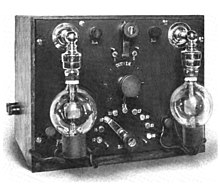Audion
The Audion was an electronic detecting or amplifying vacuum tube[1] invented by American electrical engineer Lee de Forest as a diode in 1906.[2][3][4][5] Improved, it was patented as the first triode in 1908,[1][6][7][8][9] consisting of an evacuated glass tube containing three electrodes: a heated filament (the cathode, made out of tantalum), a grid, and a plate (the anode).De Forest found that gas in a partial vacuum heated by a conventional lamp filament behaved much the same way, and that if a wire were wrapped around the glass housing, the device could serve as a detector of radio signals.He eventually discovered that connecting the antenna circuit to a third electrode placed directly in the space current path greatly improved the sensitivity; in his earliest versions, this was simply a piece of wire bent into the shape of a gridiron (hence grid).In 1914, Columbia University student Edwin Howard Armstrong worked with professor John Harold Morecroft to document the electrical principles of the Audion.[13] In March and April 1915, Armstrong spoke to the Institute of Radio Engineers in New York and Boston, respectively, presenting his paper "Some Recent Developments in the Audion Receiver", which was published in September.His first success was in demonstrating that, contrary to what Edison and others had long asserted, incandescent lamps could function more efficiently and with longer life if the glass envelope was filled with low-pressure inert gas rather than a complete vacuum.Again contrary to what had been widely believed to be possible, by virtue of meticulous cleanliness and attention to detail, he was able to produce versions of the Fleming Diode that could rectify hundreds of thousands of volts.He soon realized that his "vacuum" Audion had markedly different characteristics from the de Forest version, and was really a quite different device, capable of linear amplification and at much higher frequencies.


- Bottom row (D): De Forest Audions and oscillaudions
- Third row (C): Pliotrons, developed at General Electric by Langmuir
- Second row (B): triodes developed at Western Electric which bought the rights from de Forest in 1913.
- Top row (A): French triodes. The French government gained the right to manufacture Audions in 1912 when de Forest failed to renew his French patents for lack of $125.

Audion (disambiguation)Triodevacuum tubeLee de Forestglass tubeelectrodesfilamenttantalumhistory of technologyamplifyresidual gasdynamic rangedetectorFleming valveradio receiverselectronic oscillatorsradio receiverde Forestelectrically conductiveradio wavesvacuumpatentsgridirontelephone repeater amplifierJohn Ambrose Flemingthermionic valveColumbia UniversityEdwin Howard ArmstrongoscilloscopeInstitute of Radio EngineersregenerationIrving LangmuirGeneral ElectricWestern Electricdetectorscoherersbarretterscrystal detectorsgalenacat's-whisker detectorradio transmittersWorld War IWestern worldtransistorelectronicssolid stateintegrated circuitsradio transmitterAM radiooscillatorradio broadcastingArmstrong, E. H.WikisourceLangmuir, IrvingElectronic componentsSemiconductordevicesMOS transistorsBiCMOSBioFETChemical field-effect transistorComplementary MOSDepletion-load NMOSFin field-effect transistorFloating-gate MOSFETInsulated-gate bipolar transistorMOS field-effect transistorMulti-gate field-effect transistorPower MOSFETThin-film transistorOther transistorsBipolar junction transistorDarlington transistorDiffused junction transistorField-effect transistorJunction Gate FET (JFET)Organic FET (OFET)Light-emitting transistorOrganic LET (OLET)Pentode transistorPoint-contact transistorProgrammable unijunction transistorStatic induction transistorTetrode transistorUnijunction transistorDiodesAvalanche diodeConstant-current diodeGunn diodeLaser diodeLight-emitting diodeOrganic light-emitting diodePhotodiodePIN diodeSchottky diodeStep recovery diodeZener diodePrinted electronicsPrinted circuit boardHeterostructure barrier varactorIntegrated circuitHybrid integrated circuitLight emitting capacitorMemistorMemristorMemtransistorMemory cellMetal-oxide varistorMixed-signal integrated circuitMOS integrated circuitOrganic semiconductorPhotodetectorQuantum circuitRF CMOSSilicon controlled rectifierSolaristorStatic induction thyristorThree-dimensional integrated circuitThyristorTrancitorVaricapVoltage regulatorsLinear regulatorLow-dropout regulatorSwitching regulatorBuck–boostSplit-pi